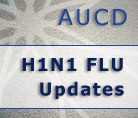H1N1 Flu
AUCD's H1N1 Flu Information Webpage provides the latest state and federal guidance on planning for and responding to the needs of individuals with disabilities. People with disabilities are part of an at-risk group that spans all other vaccination priority groups (pregnant woman, children from 6 months to 24 years, caregivers for those under 6 months, healthcare and emergency services personnel, and persons 25 through 64 who have health conditions associated with higher risk of medical complications from influenza) with respect to H1N1 and the seasonal flu.
The website is updated as information becomes available. Please send Katy Beggs or Danielle Edson any suggestions for additional H1N1 resources to add to the site. Two websites that are updated regularly and have a great deal of information are:
State and Local Resources
Access a list of resources by state or territory.
NEWS
1/11/2010
2009 H1N1 Influenza and its Impact on People with Chronic Medical Conditions
Date: January 12, 2010, 2:30-3:30 pm Eastern Dial-in number: 1-800-857-4785, passcode 9335569 This webinar is presented in conjunction with National Influenza Vaccination Week (NIVW) by the US Department of Health and Human Services, CDC, American Cancer Society, American Diabetes Association and American Lung Association.
12/3/2009
H1N1 Information for Parents who have Children with High-Risk Medical Conditions
Podcast given by Dr. Georgina Peacock, Co-lead of CDC's H1N1 Children's Health Team
This podcast contains information for parents about children with high-risk conditions and flu. The podcast is approximately 8 minutes long and provides valuable information for parents.
11/5/2009
HHS Orders Intravenous Antiviral Flu Medication to Help Patients Hospitalized with 2009 H1N1
The U.S. Department of Health and Human Services (HHS) today announced contract awards for up to 120,000 treatment courses of intravenous (IV) antiviral drugs to help treat hospitalized 2009 H1N1 influenza patients.
MAIN HEADER WILL BE DISPLAY HERE
RESOURCES
H1N1 - Information for People with Disabilities and Medical Conditions
1/14/2010
Providing Services to Children with Disabilities
The H1N1 influenza virus has the potential to pose a serious risk to children, especially those with certain underlying conditions making them more susceptible to the flu. This guidance outlines states? responsibilities to these infants, toddlers, and children with disabilities and their families, and to the staff serving these children.
12/30/2009
2009 H1N1 Flu and People with Disabilities
CDC has posted information about 2009 H1N1 Flu for people with disabilities and their caregivers on its Web site.
12/15/2009
Seasonal and 2009 H1N1 Flu: For Parents Who Have Children or Adolescents with High-Risk Medical Conditions
This brochure for parents provides specific information regarding what children are considered to be at risk, as well as guidance on symptoms, vaccines, and treatment.
H1N1 - Information for Healthcare Providers, Universities, and Community-Based Organizations
12/3/2009
H1N1 - AUCD and UCEDD Contacts
12/3/2009
H1N1 - Children's Hospital Contact List
12/3/2009
H1N1 - Organizations Serving Children With High Risk Conditions
H1N1 - General Information
12/3/2009
H1N1 - AUCD and UCEDD Contacts
12/3/2009
H1N1 - Children's Hospital Contact List
12/1/2009
WHO Update International Flu Situation
As of 22 November 2009, worldwide more than 207 countries and overseas territories or communities have reported laboratory confirmed cases of pandemic influenza H1N1 2009, including over 7820 deaths. As many countries have stopped counting individual cases, particularly of milder illness, the case count is likely to be significantly lower than the actual number of cases that have occurred. WHO is actively monitoring the progress of the pandemic through frequent consultations with the WHO Regional Offices and member states and through monitoring of multiple sources of data.
Emergency Preparedness Resources
10/19/2009
Project REDD
10/13/2009
State Emergency Planning and Preparedness Recommendations for Maternal and Child Health Populations
Inclusive Preparedness Center
The Inclusive Preparedness Center focuses on ensuring all individuals are included in planning for and protection from both natural and man-made disasters.








